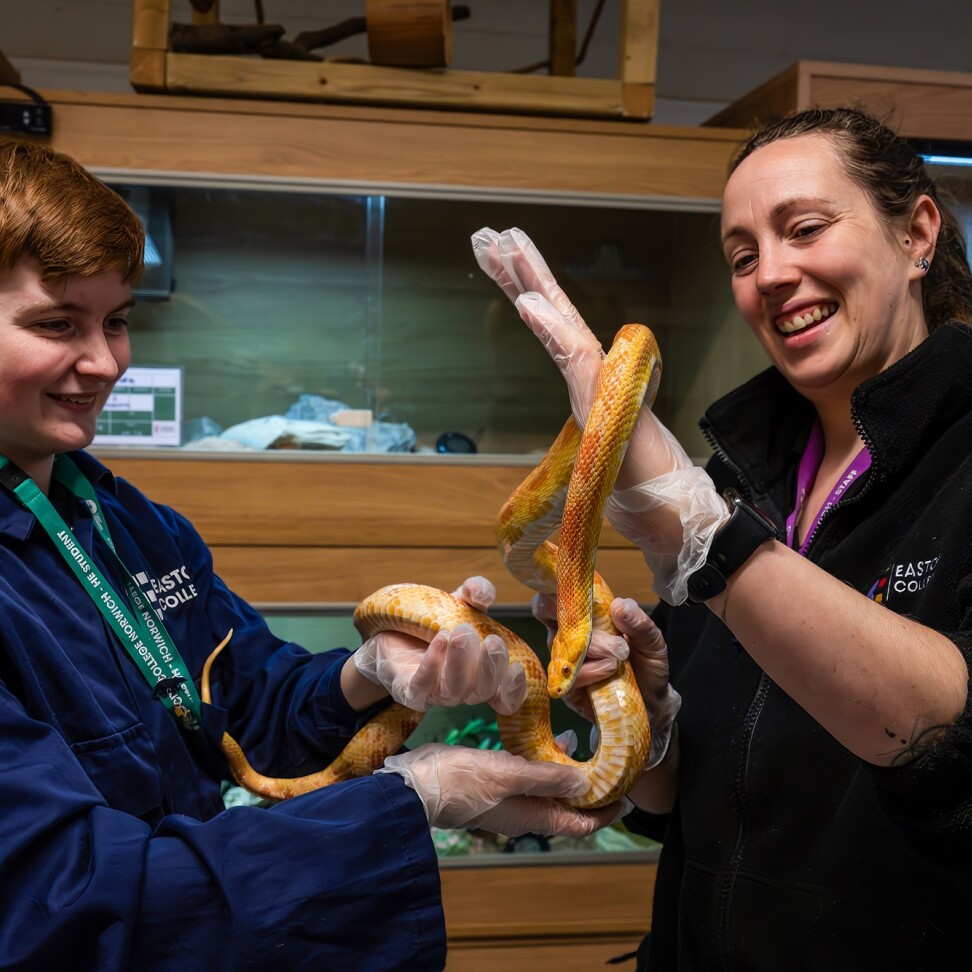BSc (Hons) Zoology

Zoology incorporates the study of biology, ecology and biodiversity in order to better help manage and conserve the Earth's fragile ecosystems. Our BSc (Hons) Zoology degree provides you with the practical and theoretical knowledge to approach contemporary challenges locally, nationally, and globally.
This programme is subject to validation / revalidation by UEA, ready to accept new entrants from September 2026. Therefore, for next year there may be some changes to this advertised course content following this process.
- Level
- 6
- Entry Point
- Sep 2026
- Duration
- Full Time, 3 years
- Venue
- Easton College campus
- UCAS Course Code
- C300
Reasons to study
this course
You will cover global biodiversity, British wildlife, marine biology, coastal ecology, and environmental animal physiology. This is likely to include a range of science and practical modules to help develop the skills needed for careers in conservation and working with wildlife.
You will develop an understanding of both native and global animal and plant species, whilst also being able to develop your individual interests further through project-based research. This course will also provide a good knowledge base for you to continue into further study at master’s level.
This course focuses on wild animal species, their behaviour and ecology, compared to our BSc (Hons) Animal Science programme which focuses on animals in domestic, farm and zoo-based settings.
Rosa Andrews - Course Leader BSc (Hons) Zoology
Where will this
course take you?
On successful completion of the BSc (Hons) students may apply seek provision for post graduate study in similar subjects at other institutions (subject to entry requirements).
You may also choose to enter employment or graduate internships in a range of industry based careers such as research, working within zoological collection, conservation roles, entomologist, marine scientist, environmental consultancy, field trials officer.
Course structure
This course is studied full time over three years. The programme is delivered over two days a week - 30 teaching weeks per year.
Level 4 modules
Animal Anatomy and Physiology Compulsory
The animal body is remarkably well designed. Different parts of the body must work together in perfect harmony to maintain life. Health may seem to be the normal situation, but for the body to maintain life, incredibly complicated processes must occur. The relationship between disease and anatomy is strong. Disease affects anatomy and abnormal anatomy causes disease. Normal anatomy and physiology are essential for the animal’s health, welfare and survival. The study of anatomy and physiology gives insight into each animal species and gives us the ability to influence an animal’s survival, when there is dysfunction of the normal anatomy and physiology.
Assessment:
- Exam (70% of module weighting)
- Scientific Report (25% of module weighting)
British Wildlife and Identification Compulsory
British wildlife and their habitats have been shaped by hundreds of years of human intervention leading to a diversity of habitat types unusual for such a small land area. Site management requires a good knowledge of the range of appropriate management techniques available for each habitat as well as a sound base in ecological principles.
This module aims provides you with the skills and knowledge to identify a range of British wildlife and habitat types. This will include the recognition of dominant and characteristic vegetation as well as knowledge of significant plant and animal species found within each habitat. The ability to identify key species from a wide range of taxa is key to appreciating the biodiversity value of a range of habitats. You will develop an understanding of the abiotic and biotic relationships that determine the nature and diversity of each habitat. Adaptation of species to their given habitat will also be explored.
The module develops your understanding about the strategies for conserving species and habitats in the United Kingdom The anthropogenic impacts on UK wildlife will be considered and what mechanisms are in place to protect wildlife in this country from the impacts of farming, urban development, pollution and alien species. If the multifunctional nature of land in the British countryside is to be conserved, then a balance must be found between conflicting land users.
Assessment:
-
Case Study (50% of Module Weighting)
-
Collection (50% of module weighting)
Principles of Biology Compulsory
This module provides you with the essential background knowledge in cellular and molecular biology with an emphasis on genetics and evolution. You will become familiar with cellular structures and functions and the classification of living organisms.
The module aims to develop your knowledge and understanding of plant and animal physiology alongside with the homeostatic processes that are essential in ensuring the survival of the organism in constantly changing environments.
The module introduces you to the mechanisms of heredity including cell division, sex determination and the laws of inheritance. You will also examine the processes which drive evolution, the concepts of natural selection and events which upset the population genetics including genetic drifts and founder effect.
This module aims to introduce you to, and develop, your observational and practical skills using light microscopy, breeding Drosphila melanogaster and using molecular techniques such as electrophoresis. These practical activities will improve your understanding and practical skills in biological science, the fundamental processes in living organisms and of contemporary scientific technologies.
Assessment:
-
Exam (60% of module weighting)
-
Academic Poster (40% of module weighting)
Principles of Environmental Science and Ecology Compulsory
Environmental systems underpin the ecology of life on Earth, providing the physical resources to maintain the flora and fauna that a growing human population relies on. Each natural system is intrinsically linked and balanced but the exploitation of these systems and their resources has led to increasing concerns for the future well-being of a growing global population and the Earth’s ecosystems.
Ecology is essential to our understanding of how to manage the land, its’ resources and biodiversity. Land use, policy and practice has often proved disastrous where there has been a lack of understanding of the way populations and ecosystems function at both large and small scales. This has resulted in declines in biodiversity and soil productivity.
This module aims to provide you with a broad understanding of the Earth’s natural system and an underpinning understanding of soil and water resources is essential to the sustainable management of the local, national and global environment. You will explore and examine geographical climate patterns and the impact that climate change is having on global populations, ecosystem services, and the policy decisions used in mitigation.
The module allows you to learn fundamental ecological theories in terms of the way that individuals, populations and species grow, interact and are distributed. The way in which energy is transferred through ecosystems and impacts on the length of food chains and numbers of individuals at varying trophic levels will be considered and it will further review the manner in which ecosystems alter with time and the influence of living organisms on successional processes.
You will also have the opportunity to build practical skills in assessing environmental systems and the analytical skills to discuss the complex issues that influence resource use. Furthermore, an understanding of these principles will be key to help graduates towards following a more sustainable path in the development of policies, management plans and personal choice.
Assessment:
-
Essay (50% of module weighting)
-
Examination (50% of module weighting)
Professional and Academic Skills Core
Professional and Academic Skills is a core module and designed to aid your success in your programme of study.
This module aims to:
-
provide a framework of professional and academic skills at undergraduate level
-
promote your recognition of the value of research, critical analysis and reporting in the context of your programme specialism
-
aid in the identification and development of a developmental approach to learning and to the professional skills required for employment
Having completed this module, you should be able to:
-
use a range of academic approaches and techniques
-
reflect on your personal performance and development in a range of professional and academic skills
-
apply appropriate judgement in selecting and analysing academic sources and data
-
communicate effectively with peers, assessors and wider audiences in a variety of media
-
apply the Harvard Referencing System correctly and consistently in work products
-
meet the professional standards for graduate employment your industry/career path
Whilst delivery and the learning outcomes are generic the content and output of your work will reflect to programme specialism you are studying towards.
Assessment:
-
Group Presentation (50% of module weighting)
-
Reflective Journal (50% of module weighting)
Wildlife Management Compulsory
The number of species moving towards extinction is increasing due to many factors eg climate change, loss of habitat due to human population growth and resource removal. Habitat is lost due to urbanisation, agriculture and pollution, while individual species are treated as resources and exploited for food, medicines, pets and scientific research. If we are to maintain the Planet’s biodiversity species conservation in situ must be a priority. Where species are already on the brink of extinction captive breeding programmes are often viewed as the only hope of maintaining and enhancing wild populations.
Monitoring existing populations and habitats is critical in assessing the urgency of the issues involved in wildlife conservation and sustainable population management and techniques utilised are discussed.
This module develops your understanding of the problems facing wildlife and the implications thereof. The conservation and management of wildlife in situ is considered. The issue of human intervention and its nature is reviewed, together with the ethical and legal implications of wildlife management practices.
Assessment:
-
Essay (50% of module weighting)
-
Presentation (50% of module weighting)
Level 5 modules
Behavioural Ecology Compulsory
This module will explore the inter-relationships between behaviour, ecology and evolution of animals and plants. You will learn why organisms behave the way they do under particular ecological conditions and how they respond and adapt to changes in their environment. The principal models and theories in relation to behaviour and behavioural ecology will be examined, using case studies and examples to illustrate.
You will explore the evolution of specific behavioural patterns and have the opportunity to undertake some original research in behavioural ecology on a selected species. This will involve experimental design, research, interpretation, analysis, and presentation of results. Through understanding key concepts of behavioural ecology students will be able to make more informed choices with regards to conservation within other subject areas such as habitat management and countryside recreation.
Assessment:
-
Exam (50% of module weighting)
-
Experimental Project Report (50% of module weighting)
Global Biodiversity Compulsory
As a result of the Rio Conference, 1992, the concept of biodiversity, and its importance in maintaining a sustainable global environment, gained prominence. Since that time there has been a significant decline in global biodiversity and serious concerns that we may be facing another mass extinction. It is now of fundamental importance that humans understand the mechanisms that drive areas of high biodiversity, where these hotspots are found, what are the threats and what can be done to negate the impacts.
This module provides an understanding of the phenomenon of biodiversity and investigates the factors that promote it and those that threaten it. You will explore the mechanisms by which biotic diversity is generated and explores the benefits that are associated with biodiversity. You will have the chance to discuss the threats facing biodiversity on a local and global scale and will be encouraged to explore and evaluate practical conservation measures to ensure the maintenance and enhancement of biodiversity for future generations.
The modules aims to allow you to develop an appreciation of the value of biodiversity as a resource in economic and aesthetic terms from the value of an individual organism to large scale ecosystem services/natural capital. It will provide you with a sound theoretical framework from which to assess the significance of local, national and international developments on the world’s biodiversity.
Assessment:
-
Case Study (50% of module weighting)
-
Examination (50% of module weighting)
Introduction to QGIS Compulsory
This module will provide you with valuable practical skills in the use of Geographical Information Systems through the understanding of the concepts and training during practical sessions (two third of the face-to-face teaching time). You will discover, using relevant case studies, how to use Open-Source software (QGIS). You will also explore a variety of resources for spatial data at both local and global scales including species distribution, protected areas, habitats maps, satellite images, etc. You will learn how to collect spatial data in the field using GPS and tracking devices, how to manage and insert these data into QGIS, how to explore and analyse the data and how to create high quality cartographic and non-cartographic outputs. The practical sessions will cover a variety of techniques on how to use, analyse and represent available spatial data relevant to the study of terrestrial and marine organisms in the context of ecological and behavioural studies and wildlife conservation.
The theory of QGIS and its uses in biology are assessed through a short essay assessment. The practical skills are assessed through a scientific report demonstrating the use of QGIS to answer a biologically relevant question. You can either use a dataset provided by the lecturer or are free to use any available spatial dataset. Assessment focuses on the correct use of the QGIS tools and methods and the quality of the cartographic output. This module provides strong links to employment, as the knowledge of QGIS and the use of these techniques are valuable practical skills in industry.
Assessment:
-
Essay (30% of module weighting)
-
Scientific Report (70% of module weighting)
Invertebrate Zoology Compulsory
Building on earlier study of evolution and diversity of animal life on Earth, this module provides a more focused exploration of the invertebrate classes. The evolutionary history of the subphylum will be examined along with anatomical plans of the major groups of invertebrates and links made to function.
In this module you will have the opportunity to examine the comparative biology of invertebrates in an evolutionary and phylogenetic context with an emphasis on functional morphology.
You will study topics such as an introduction to invertebrate systematics and different classification methods, an overview of systems used for locomotion, nerves, sensory perception, feeding, digestion, excretion, growth, circulation, respiration, and reproduction.
Assessment:
-
Drawing Report (50% of module weighting)
-
Essay (50% of module weighting)
Research Skills Core
This module is designed to help you further develop the learning and development skills introduced in the Higher Learning Skills module in Year 1 (or its equivalent). It offers the opportunity to focus on practice-based research and evaluation skills.
The module will enhance your understanding of qualitative and quantitative methodologies, research methods, and critical thinking skills relevant to the subject area. This will lay the foundation for research at Level 6.
Assessment:
-
Open book time-constrained assignment (70% of module weighting)
-
Research Proposal (30% of module weighting)
Vertebrate Zoology Compulsory
Building on your earlier study of evolution and the diversity of animal life on Earth, this module provides an exploration of the vertebrate classes. You will examine the evolutionary history of the subphylum, along with the anatomical plans of the major groups of vertebrates, and explore the links to their functions.
This module aims to introduce you to the origins of the vertebrate classes, outline key steps in their evolutionary history, and help you understand the functional aspects of their major morphological characteristics and life history features.
You will focus on the anatomy and physiology of vertebrates from an evolutionary perspective, illustrating the diversity within vertebrate groups. You will define and discuss the essential features of Chordates, from which vertebrates evolved, and identify the basic feeding, respiratory, and locomotory adaptations of fish. The evolution of land vertebrates will then be discussed, from lobe-finned fishes to early amphibians.
You will explore the diversity of amphibians, the evolution of the amniotic egg, and the contrasting water relations of amphibians and reptiles, before studying the evolutionary history of birds and mammals, including the rise of endothermy and their primary reproductive and locomotory adaptations.
Assessment:
-
Drawing Report (50% of module weighting)
-
Essay (50% of module weighting)
Level 6 modules
Animal Social Behaviour Compulsory
Animal behaviour is a popular study for biologist and zoologists providing insights into the ways animals survive and reproduce within their dynamic environments. This module further focuses into the suite of interactions that occur between two or more individual animals. This could be animals of the same species where they form simple groups, cooperate in sexual and parenting behaviours, engage in territorial disputes, access suitable mates or cross spaces. It may also include interspecific interaction.
In this module you will examine and assess the neurobiology and endocrinology surrounding social behaviours. This builds on modules and topics from Level 4 and 5 of your study in anatomy and physiology and behavioural ecology. You will have the chance to explore a range of species and their interactions in domestic, captive and wild settings underpinned by theories and research. The module allows you to explore a range of social species and further hone your knowledge and practical ability in designing and undertaking experiments to analyse social animal behaviour.
By studying this module you will be further equipped for postgraduate research or employment in the wildlife, conservation and zoology industries with skills and knowledge linking social behaviour to the successful welfare, conservation and management of social species.
Assessment:
-
Examination (40% of module weighting)
-
Report (60% of module weighting)
Conservation Biology Compulsory
Conservation Biology is the scientific study of biodiversity with the aim of protecting species, habitats and ecosystems. In this module students will review biodiversity and its importance. Threats to biodiversity will be critically analysed within the context of sustainability. Global climate change is a significant factor affecting the distribution of the flora and fauna of planet Earth. Maintaining biodiversity with a growing human population must be a priority. Recent research suggests that the Earth is experiencing its sixth mass extinction event in its history and much of this is attributed to habitat degradation arising from human development and overexploitation of the Earth’s resources. Some species are more vulnerable to extinction than others. In this module students will review the drivers of extinction utilising the IUCN Red List and other conservation assessment tools to assess the conservation status of individual species and to identify which species to save. The ethics of saving only charismatic species, umbrella species and flagship species versus saving other species will be examined.
There are a range of conservation management strategies, and some are more successful than others. You will appraise the features of effective conservation programmes and identify reasons for failures of others. Methods for measuring outcomes in conservation will be critically analysed. Animal welfare is a significant factor in saving species from extinction. You will explore which aspects of animal welfare are fundamental to the success of captive breeding programmes. Comparing and contrasting issues and case-study examples from in-situ and ex-situ breeding programmes will enable you to justify the most effective approaches for breeding animals in captivity for conservation. The vital roles of population structure and genetic diversity will be evaluated alongside welfare aspects within the context of releasing animals from captive breeding programmes into the wild to create sustainable wild populations. Field study excursions to a range of collections will support research into welfare and population management. Through understanding the processes involved in breeding and managing captive species, students will be encouraged to question traditional and modern techniques in conservation. The core of the module will be delivered by Easton campus staff together with significant input from practicing researchers and practitioners in conservation. Guest speakers from ancillary businesses, conservation projects and charities will also be involved.
Assessment:
-
Field Study Report (50% of module weighting)
-
Essay (50% of module weighting)
Dissertation Core
This module allows you to work on an academic research project of your choice, utilising evidence-based methodologies and appropriate research tools. The project can be conducted in collaboration with local businesses or charities, and may involve using existing data, collecting your own data, or undertaking an evaluative study. You will be assigned a supervisor to provide guidance on your topic choice and monitor your progress. The research project will serve as a summative exercise to help you evaluate your academic progress throughout the degree programme. Through which to evaluate their own academic progress during the degree programme. The dissertation can take the form of either a discursive, structured, and evaluative thesis or a data-based project. You will have the opportunity to design and implement a research project, involving the collection, analysis, and interpretation of original data in light of existing knowledge. This will also equip you with practical skills in participant recruitment, research ethics and design, project management, data analysis, and communication, all of which will enhance your employability profile.
Assessment:
-
Report (90% of module weighting)
-
Presentation (10% of module weighting)
Environmental Animal Physiology Compulsory
Environmental animal physiology investigates how animals function in different environments—from deep seas to seashores, from the top of mountains to lakes or deserts. Virtually every aspect of any environment that we could consider impinges on an animal’s physiology: its existence, its ability to obtain food and energy, its dispersion or migration, and its reproduction.
Environments are rarely constant, particularly on land, and to survive animals must cope with whatever changes they meet. Environmental physiology explores how animals respond to environmental changes, whether these occur daily, seasonally, or as long-term trends that could affect populations.
To understand how animals function, we need to know the mechanisms by which organs, such as the heart, kidneys, and muscles, function and how these are controlled by nerves and hormones.
These topics will be studied via a range of lectures, laboratory, and field sessions, to understand why animals occur in certain ecosystems, while others do not.
Assessment:
-
Exam (70% of module weighting)
-
Investigative Report (30% of module weighting)
Science Communication for Conservationists Compulsory
This module aims to give you an understanding of how modern science is disseminated to the public via a range of science communicators and how science is communicated to governments, politicians, and policy makers. You will examine strong and poor strategies for communicating science to various audiences and how science information and misinformation can be used to change public perception.
You will examine the role of written press, TV, radio, websites, blogs, etc. and using case studies, will look at the approach of the press and the impact on the public and government policy. Examples utilised will be current within the industry and research fields, which may include topics such as climate change, land management, biodiversity loss, rewilding, and invasive species. You will use reflections on these strategies to create select forms of media to engage a range of audiences.
This module aims to provide you with a series of multidisciplinary skills for use in industry and academia. Continuous technological advancements mean that animal scientist roles can range from field work to marketing and liaising with the public or government officials.
Assessment:
-
Presentation (50% of module weighting)
-
Multimedia and Reflection (50% of module weighting)
Course details
Assessment methods
The programme provides you with a range of opportunities to display your understanding and application of the subject informally prior to summative assessments that will count towards your final grade. A range of methods are utilised to assess performance including (but not limited to) examinations, essays or literature reviews, presentations, posters, portfolios, observed practical work and project reports. The grades from each formal assessment count towards an overall module grade. The balance of assessment by examination and assessment by coursework depends on modules selected.
Awarded by
This course is awarded by the University of East Anglia and regulated by The Office for Students.


Entry requirements
UCAS points
Our typical offer is 80 UCAS tariff points from A Levels or equivalent
GCSEs
GCSE English, Maths and Science (preferred) at Grade C/ Level 4 or above
Scottish Highers
UCAS points from Scottish Highers or Advanced Levels are accepted
BTEC
UCAS tariff points from BTEC are accepted
T Levels
T Levels are accepted
City and Guilds
City and Guilds diplomas are accepted
Open University
Open University credits in lieu of A Levels are accepted
Access to HE Diplomas
Access to Higher Education Diplomas are accepted
We will also accept applications from students who have passed, or are predicted to gain a pass grade in the following specific course programmes, listed below:-
- T Level: Animal Management and Behaviour Level 3
- T Level: Animal Management and Science Level 3
- BTEC Level 3 Extended Diploma Equine Management
- BTEC Level 3 Extended Diploma Equine Performance and Excellence
- Access to Higher Education: Land-based Studies (Animal and Countryside Management)
Contextualised Offer
You may also be eligible for a contextualised offer for this programme, please see our Contextualised Offer page for further details and to check your eligibility
Course fees
£9,535 per year for UK students.
£15,052 per year for international students (students from outside of the UK).
Other course costs
It would be good to invest in a warm waterproof coat, wellie boots, waterproof trousers and sturdy walking boots. You may also find it useful to have binoculars. There may also be trips that require a contribution.
We were awarded a TEF Silver rating overall in 2023, achieving this for both student experience and student outcomes.

Search courses
Search CCN HE




